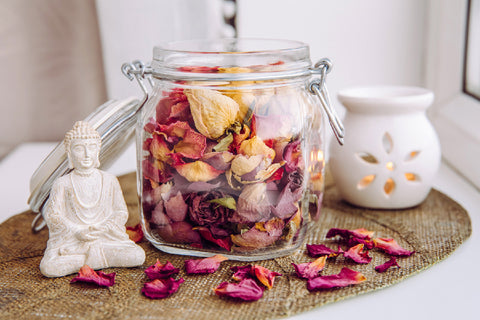Nowadays, people are getting more attracted towards things that are more natural and contain extracts taken straight from organic plants and herbs. This is also the reason why you might find dried flowers for soap making a new popular practice being loved by netizens nowadays.

In fact, you might have already seen a lot of soaps featuring dried flowers. Their amazing smell adds to the beauty of the soap. Some flowers add their own fragrance and colour texture to the soaps that amp up the visual interest too. If you love DIY soap making, you must know about this subject. Let s discuss the use of dried flowers for soap making and how you can use it for making soaps.
Top 5 Dried Flowers For Soap Making
Now, we know that dried flowers are used for soap-making projects, but do we know which flowers we should prefer? So, here are some of the best flowers to use in your homemade soap recipes in their dry form.
1.) Dried Rose Flower
Dried rose flower is foremost the best choice when it comes to fragrant soap making. Rose-dried flowers are ideal for both cold-process and hot-process soap-making projects.

The flower imparts your soap bars its natural pinkish colour. Rose also imparts skin-regenerating and healing properties to the soap. Soaps featuring dried rose flowers soften and condition skin.
2.) Dried Lavender Flower
Lavender is one of the best-smelling flowers after rose, especially in its dried form. The deeply fragrant flower adds a very mesmerizing smell to your DIY soap bar. In addition, it also contains many beneficial properties for the mind and body, making it an ideal ingredient to be added in the soap-making process.
3.) Dried Hibiscus Flower
The dried flowers protect the skin with their rich level of antioxidants and fight skin inflammation.

Hibiscus is an age-old flower that has been a prime choice for making soaps. Using dried hibiscus flowers not just imparts colour to your soap but also make it beneficial.
4.) Dried Calendula Flower
Calendula is a skin-beneficial plant, and thus it is one of the best choices to be used as a dried flower form for soap making. This flower withstands the soap-making process and comes out in its original colour. Dried calendula flowers naturally colour your soap bars and also make them beneficial for your skin.
5.) Dried Chamomile Flower
Dried chamomile flower comes with a sweet scent that is quite favourable for both cold-process and hot-process soap making.

Dried chamomile flowers make a great addition to handmade soaps because it offers a potential range of benefits for the skin.
How To Use Dried Flowers For Making Soap?
We are now pretty much aware of the different flowers that can be used in the dried form for making soaps. It's time for us to understand how to use those dried flowers for soap making. Let us discuss this in detail.
1.) Dried Flowers in Cold Process Soap Making
The dried calendula blooms are the best-dried flower you can add while following the cold process of soap-making. Also known as pot marigolds, these are the best-dried flowers you can add to your cold-process soap-making format. Here's how you can add dried flowers in Cold process soap.
- Lightly shred out all the dried calendula flower petals.

- Now add the flower petals to the soap right at the trace during the soap-making process.
- This way, they will retain their colour beautifully and also add a lovely texture to the soap.
So, this is how you can add dried flowers in cold process soap making. Just remember there are just a few flowers that have the ability to retain their colour in cold-process soap making. Thus, you will have to choose the right dried flower accordingly.
2.) Dried Flowers in Melt and Pour Soap Making
The melt-and-pour method will be more successful if you're determined to manufacture soap with dried flowers. When working with a clear foundation, the flowers embedded in the soap are visible. Melt & pour soap has a significantly larger assortment of useable flowers than cold process soap.
Here's how to add dried flowers to melt and pour soap:
- Shred your choice of dried flowers.
- Now place the flowers in the mold and then pour it into the liquid soap.

- Leave a little space at the top of the mold.
- You can even use a toothpick or similar tool to position the flowers in the liquid.
- About 20-30 minutes later, then pour a little more liquid soap on top of the initial pour to have a smooth surface.
For melt and pour soap making, you can also use a layering technique. In this, you can put on soap liquid and flowers layer by layer into the mold.
Conclusion
So, this is how you add or use the different types of dried flowers for soap making. Whenever you are using the cold-process technique or the melt-pour one, both of the techniques are okay for adding dried flowers as a fragrant ingredient. So, next time you are going to try DIY soap making, do remember to add dried flowers to it and increase the efficiency of your homemade soaps naturally.
Frequently Asked Questions
Welcome to our comprehensive FAQ section on Dried Flowers For Soap Making!
Q. Can you put dried chamomile flowers in soap?
A. Yes, you can use chamomile flowers in your soap-making process to decorate your soap bar as well as to add a magnificent fragrance to it.
Q. Is lavender flower good for the skin?
A. Yes, lavender, a dried flower, is very good for the skin as it reduces the signs of ageing and also softens the skin. So, you can surely add it to your soap bases.












 Sign in
Sign in Register now
Register now My Reward Points
My Reward Points









